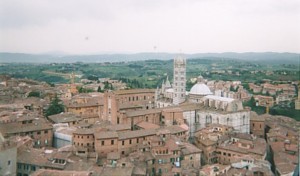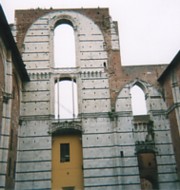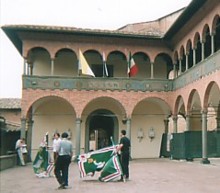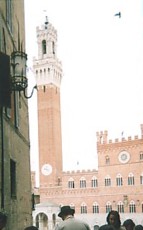Siena tourist information, hotel and travel guide
Siena is one of the most appealing towns in Tuscany, one of Italy’s most appealing regions. The well-conserved medieval streets and piazzas are home to the annual festival of the Palio, a neck-or-nothing horserace which takes place in Siena’s main square, the Campo. The town can be reached as a daytrip from Florence or Rome, but it’s also a good place to stay for several days, soak up the atmosphere, and visit the surrounding Tuscan countryside. The town is still sometimes known by its alternative English spelling of Sienna.
Siena tourist attractions and holiday information
Historical Siena is arranged around three radiating ridges of high ground, with green valleys enclosed within the old city walls. The town is divided into terzi, or thirds, and within each of these there are a number of the districts known as contrade (more about the contrade below). It’s easy to walk around the historic centre of Siena on foot, exploring as you go, but if you’re the organised type you may find it helpful to take the terzi one at a time.The Tourist Information Offices and museums supply leaflet guides to each one. The Terzo di Camollia, for example, contains the gigantic and shadowy Basilica di San Francesco, dating from the late 13th century; the rival Dominican church, the Basilica of San Domenico; the Sanctuary of St Catherine of Siena; the former Medici Fortress, which is now a pleasant and panoramic public park.

The first stop for tourists in Siena is Piazza del Campo (otherwise known simply as il Campo). This is the secular heart of Siena, a sloping amphitheatre of a square, lined with cafe tables and thronged with tourists, school parties and locals. The Campo is the dramatic setting for the Palio horserace. The piazza’s focal point is the Palazzo Pubblico, the public palace, which dates back to 1250 and is still the seat of the Municipality.
The Palazzo is also home to some fine frescoes, and makes a good beginning to your sightseeing tour. At the ticket office in the internal courtyard you can buy a range of tickets. These give access to differing numbers of Siena’s attractions, and some are valid for several days – a good way to save money, if you’re planning a longer stay. A combined ticket gives you access to the Museo Civico inside the Palazzo, and also to the tall belltower, the Torre del Mangia. The tower is an excellent way to view Siena, the views over the town and countryside are breathtaking and help the visitor understand the geography of the town. Be warned though, that the climb is also breathtaking. A limited number of people are allowed up at a time, and you’ll understand why when you see how narrow and poky the stairs are. The final climb up to the highest bell on its lofty framework is a nervewracking ladder – don’t even think of making the climb if you have a poor head for heights or are very unfit.
Moving on to the museum, highlights include superb frescoes by Simone Martini, whose Maestà religious scene is one of the oldest examples of Sienese painting and glows with colour and life. Even more fascinating is a fresco cycle by Ambrogio Lorenzetti (1319-1348), the Allegories of Good and Bad Government. In one series, a ‘good’ ruler presides over a prosperous city (Siena) and productive countryside, while the effects of bad government are shown to be dismal misery and urban deprivation. Also worth seeing are an exquisite rose-tree made of gold (a gift to Siena from a pope), and some beautiful carved choir stalls with religious illustrations (one fine example shows the dead clambering from their graves on Judgement Day).

Heading uphill from the Campo, you arrive outside the monumental green-and-white-striped Duomo, Siena’s cathedral. Before the collapse of the city’s fortunes, Siena had ambitious plans to enlarge the edifice into the largest in the world. You can still see the facade and one side of the new cathedral, which would have incorporated the older building as a mere transept. Work was stopped, but the grandiose ambitions of the Sienese were preserved in the freestanding striped walls. The interior of the cathedral itself is ornate and decorated, lined with the heads of saints. The floor is composed of extremely fine inlaid marble scenes – some are covered to preserve them from wear, but others are usually exposed in roped-off sections. The Duomo is free to visit; although there is a small charge to visit the Piccolomini Library, (off to the left of the nave), where charming courtly scenes by Pinturicchio recount the life story of Sienese Pope Enea Silvio Piccolomini (Pius II). Adjacent to the Duomo, the Museo dell’Opera Metropolitana contains much of the original artwork from the cathedral, Sienese paintings, and the opportunity to view Siena from a vantage point on the unfinished new cathedral facade.
Siena history, the Palio and the contrade

Early in its history, Siena was a Roman colony, and the later town retained pride in its past, with many statues and reminders of Romulus, Remus and the legendary she-wolf. In subsequent centuries, Siena became a prosperous and important medieval town, a rival to nearby Florence (which it famously defeated in battle in 1270). But the Black Death in 1348, and a decline in the town’s banking business changed Siena’s fortunes. A large proportion of the population died, and Siena’s star fell. Major building work on the vast cathedral extension was stopped, never to be restarted. Medieval Siena is so well-preserved because after the middle ages there was little development or industrialisation.
Perhaps because of its cultural and ecomonic stagnancy, perhaps because of a consequent need to maintain its own internal traditions, Siena has kept alive unusual and renowned traditions. In what is though to date back to a historic tribal system, the town is divided into 17 contrade, or districts. Each contrada has its own animal emblem (a caterpillar, a giraffe, a goose etc.) and its own strong identity. The rivalry between contrade is expressed twice every year in Siena’s biggest tourist attraction, the Palio. Horses representing the contrade (and blessed in their local churches) are raced perilously around the perimeter of Piazza del Campo; the whole event surrounded by an orgy of historical pageantry, flagwaving and cheering. The Palio takes place on 2nd July and 16th August; if you’re planning to visit then, it’s best to book your hotel well in advance.

Siena travel information
Get to Siena
Siena is well-served by bus services, both from the surrounding towns and from more distant destinations, such as Rome. If you are travelling by train from the north of Italy, you should change at Florence for Siena; from Rome and the south, change trains at Chiusi.
Get around Siena
Siena’s railway station is a bus-ride from the centre of town – buy your 1-hour tickets first at the newsstand in the station (you must stamp them on the bus), then cross the piazza outside the station to the bus stop on the far side. In the middle of town, Piazza Gramsci is the central pick-up and drop-off point. The centre of Siena is most easily seen on foot – there are many steep slopes, so be prepared for some exercise.
Siena accommodation
Siena has a good selection of hotels and B&Bs in the historic centre, many of them located in historic buildings with a boutique atmosphere, or period charm. Palazzo Ravizza is one of the most special hotels in the area, with history, charm, a garden and views, and Hotel Athena is another good base inside the old town walls. Il Battistero is a stylish modern B&B overlooking the cathedral with excellent reviews. There are also more independent accommodation options, like the Residenza d’Epoca Palazzo Coli Bizzarrini, which offers apartments and suites in a 16th-century building.Travellers who are touring by car might consider staying in the green countryside outside the town, where there are some special places to stay including the Villa Scacciapensieri, a popular choice set in its own grounds, with a bus connection to the centre.
> Siena hotels, B&Bs and apartments
